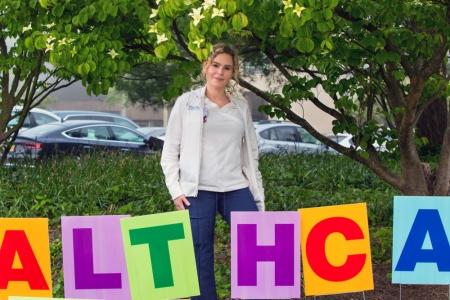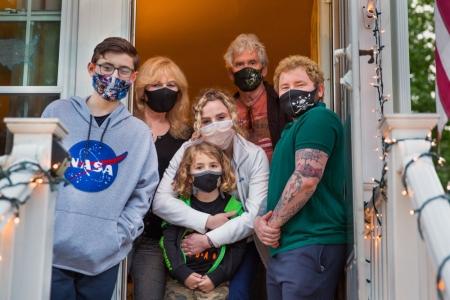'In the eye of the storm'

Bevin Sullivan leaves Staten Island University Hospital South at the end of her 12-hour shift …

… and then picks up her children at her parents’ house, where they lived full time during the height of the pandemic. On her parents’ porch are (from left) son Jason, mom Nilsa, Sullivan, son Jaxon, dad Patrick and brother Patrick Jr.
Bevin Sullivan has a different perspective on the coronavirus than most of us. She’s battled it up close and seen firsthand its devastation. As a nurse at Staten Island University Hospital South, she was “in the eye of the storm.”
“I’m not God,” says Sullivan. “I’m there to keep the patient alive. I do my job 1,000 percent even if the prognosis is poor. But it takes a huge emotional toll. One day we had four deaths in five hours.”
While the incidence of COVID-19 has dropped and her hospital is now virus-free, the pandemic crystallized Sullivan’s mission.
“To get up every morning and know I have the ability to possibly save someone’s life or change someone’s family, this is why I became a nurse,” she says. “Although it’s one of my hardest moments, it’s one of my proudest.”
It's also a moment when Sullivan stepped up.
“In the darkest moments, she was the bright light,” said Nancy Barth Miller, the Federation of Nurses/UFT chapter leader. “Not only did she take care of the sickest patients, she was the cheerleader, the morale booster, the key to keeping people focused. She reassured them not to be afraid.”
Sullivan, who is studying to be a nurse practitioner, visited all the floors to see who needed help and shared her phone number with colleagues. “Even though we had enough staff, we didn’t have enough staff trained at that acuity,” Barth Miller said. “They saw Bevin and gravitated to her.”
The UFT was a big help, Sullivan said. "Nurses were grateful for the food deliveries and extra PPE (personal protective equipment) the union provided." It was also important that union reps "were visible and walked around to tell the nurses about the support groups we have,” she said.
During the worst weeks, Sullivan sent her sons, 13 and 5, to live with her parents.
“Once her kids were safe and secure,” Barth Miller said, Sullivan “rolled up her sleeves and went to war.”
She saw her boys only outside. “I don’t hug them. I don’t kiss them. I always wear a mask,” she said at the time. “It’s a petrifying feeling, worrying about what you’re carrying.”
But she couldn’t prevent the virus from hitting home: It took her grandmother.
“She was the head of our large family,” Sullivan said. “All of us were very close with her.”
Lucille D’arpe, 85, lived in a nursing home. “She was a healthy older grandmother,” Sullivan said, “still young at heart, still walking around. It wasn’t like she was waiting to go.”
D’arpe had one advantage over other dying COVID patients.
“The nursing home was very lenient with me because I was a nurse,” Sullivan said. “They let me come with my equipment, gown up and sit bedside.”
Sullivan’s patients died without family present. Hospital staff filled in.
“You get invested in strangers — hurting for people you never met before,” Sullivan said. “Nurses were taking this emotional burden from families.”
They held patients’ hands and set up FaceTime with loved ones.
“You’re their only hope,” Sullivan said. “They lean on you tremendously. You want to be their rescue but there’s only so much you can do.”
She describes the COVID experience as “battlefield medicine,” where any noise is a trigger.
“You’re always on alert,” she said, wondering “when the next code is going to be called.”
In the middle of everything, Sullivan’s uncle was diagnosed and admitted to her hospital. She watched over him, another weight to bear.
“Coming home at night to an empty house, I had no release,” she said. Thankfully, her uncle recovered.
She and her colleagues anxiously waited for just one patient to get off the ventilator and go home. Eventually, there were several.
“It was huge. It put in perspective that we were making a difference,” Sullivan said.
On her days off, there was guilt. “You feel like you’ve got to be there, you have to help because you can,” she said. So Sullivan often worked 12-hour shifts, five or six days a week.
And then the tide turned.
“It’s mind-boggling. As fast as COVID came in is as fast as it left,” she said. One week she was caring for critically ill coronavirus patients. The next week, in the same room, it was business as usual. “You feel like you’re in a twilight zone.”
In time for Mother’s Day, Sullivan’s children came home.
“It’s like my therapy. I have two people to take care of now and it changes everything,” she said.
“The saddest part is that my 5-year-old is so stuck on COVID that everything is, ‘How long am I staying with you? Is corona gone yet?’”
Her 13-year-old understands completely and is proud of his mother. He tells her she is “doing God’s work.”
And Sullivan is ready to do it again.
“The hospital is trying to stay under capacity in case,” she said. “There is a huge thought it’s going to resurge.”